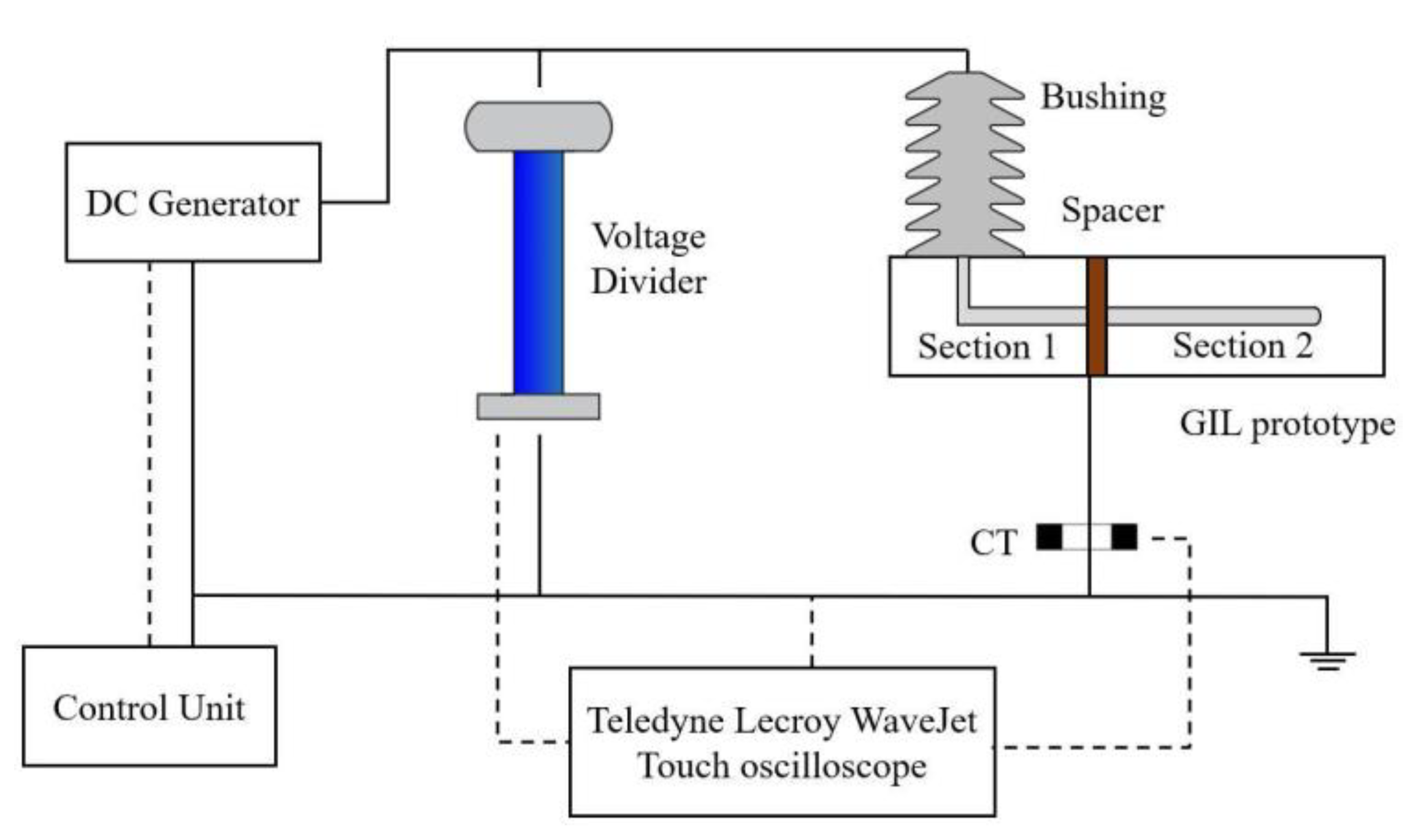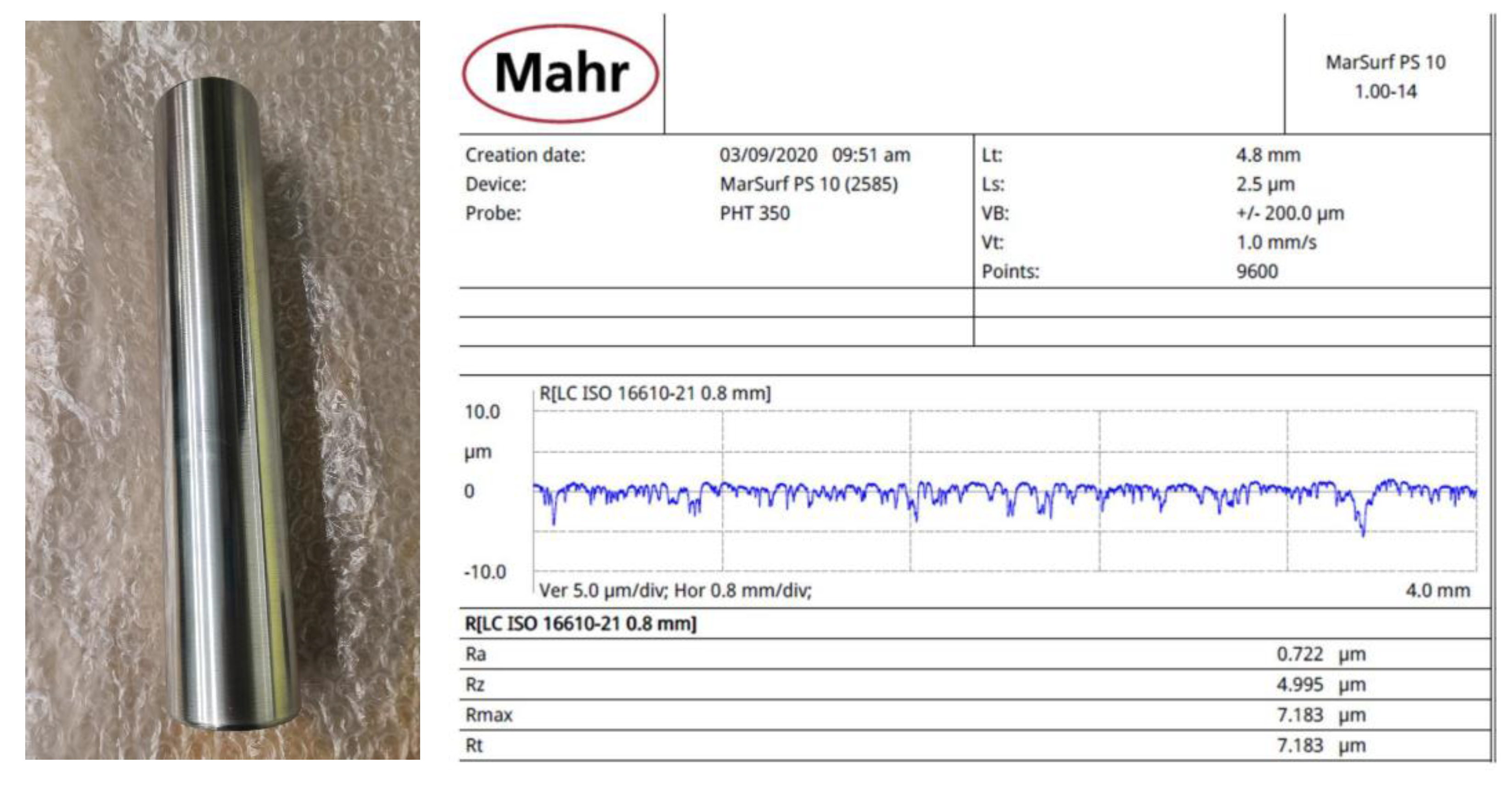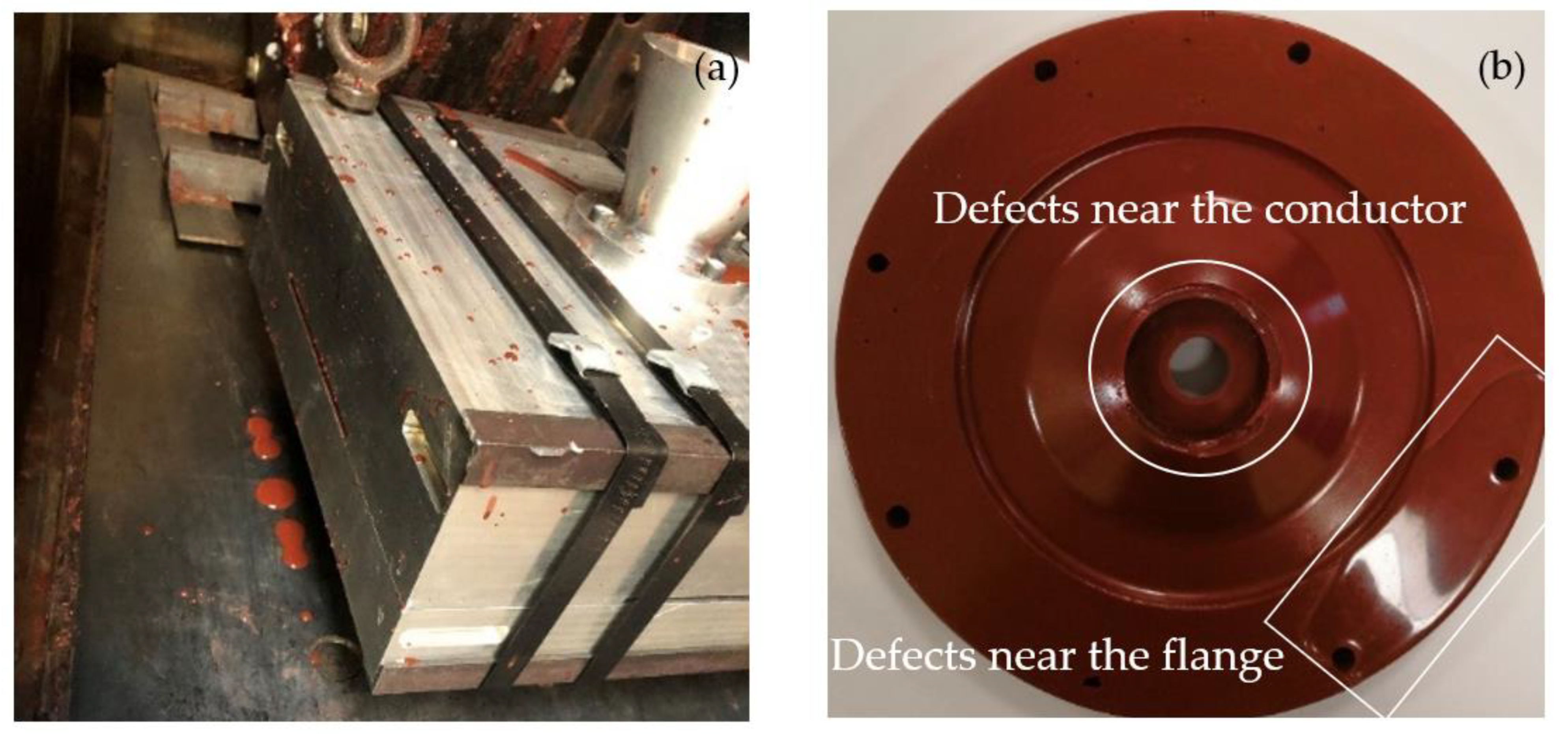Development of Future Compact and Eco-Friendly HVDC Gas Insulated Systems: Test Verification of Shape-Optimized DC Spacer Models
Abstract
:1. Introduction
- -
- Today’s geometrically optimized full-size DC spacers, by the GIS/GIL manufacturers, are either modified conical shape or disk type and are made of slightly modified chemical composition of the standard HVAC alumina filled epoxy material. It should be noted that detailed information about the manufacturers’ geometry optimization was not revealed.
- -
- For a further downsizing of HVDC GIL/GIS systems and for UHVDC systems where higher applicable electric field stresses are to be subjected, new advanced insulation technologies need to be considered, such as electric field grading materials and functional graded materials, which are still under development.
- -
- The developed SF6-free alternative gases: C5-perfluoroketone mixed with CO2 and O2, and C4-perfluoronitile mixed with CO2 have entered the market and are currently used in some commercial HVAC gas insulated systems [4,5]. However, their reliability and compatibility with HVDC GIS/GIL epoxy insulators have not been yet studied and experimentally verified.
2. Experimental Setup
- -
- A reduced-scale GIL prototype;
- -
- A Glassman ± DC generator (Max. ±125 kV) to apply high voltage through a control unit;
- -
- A voltage divider with the ratio of 2000:1 to reduce the generated voltage to a safe and measurable level;
- -
- A Stangenes Industries inc. 3-0.1 series current transformer (CT) connected to the GIL prototype to help identify whether a flashover occurred on the surface of the spacer or a breakdown across the gas gap of the prototype.
2.1. GIL Prototype
2.2. DC Spacers
3. Experimental Procedure
4. Results
4.1. Verification Tests without the Spacers
4.2. Verification Tests with the Spacers
5. Conclusions
- -
- A reduced scale gas insulated prototype to mimic the full-scale GIL/GIS system was designed and constructed. This setup fulfills the requirements of cleanliness, surface smoothness of the HV electrode and the internal walls of the grounded enclosure, as well as gas tightness. Such prototype construction was very challenging. Three SF6 alternative gases were utilized in this study which are dry air; 4% C4-PFN/96% CO2 and 30% CF3I/70% CO2.
- -
- The mold of the geometrically optimized spacer was also designed and constructed. The good functionality of this mold was checked through several epoxy vacuum casting trials to get the desired final spacers without any imperfections.
- -
- At constant temperature and under DC voltage testing up to the maximum applicable ±123 kV where ±119 kV corresponds to ±500 kV of full-size GIL/GIS, the results showed that the optimized DC spacers made of silica and alumina filled epoxy withstood these voltage levels and did not exhibit any surface flashover. These results confirmed the findings of the electric field simulations and the effectiveness of the optimized DC spacer under uniform temperature. In addition, the utilized SF6 free alternatives are compatible with the filled epoxy materials of the DC spacers.
- -
- The next step of this experimental investigation is to continue the HVDC testing on the other unexplored novel types of materials and also to verify the influence of the temperature gradient.
Author Contributions
Funding
Acknowledgments
Conflicts of Interest
References
- Koch, H. Gas Insulated Transmission Lines (GIL); John Wiley & Sons: Chichester, UK, 2011; pp. 20–26. [Google Scholar]
- Koch, H. Gas Insulated Substation; John Wiley & Sons: Chichester, UK, 2014; pp. 18–49. [Google Scholar]
- Zebouchi, N.; Haddad, M.A. A Review on Real-Size Epoxy Cast Resin Insulators for Compact High Voltage Direct Current Gas Insulated Switchgears (GIS) and Gas Insulated Transmission Lines (GIL)—Current Achievements and Envisaged Research and Development. Energies 2020, 13, 6416. [Google Scholar] [CrossRef]
- General Electric. g3 -SF6 Alternative for High Voltage Applications. Available online: https://www.gegridsolutions.com/hvmv_equipment/catalog/g3/ (accessed on 1 August 2022).
- ABB. AirPlusTM: An Alternative to SF6 as an Insulation and Switching Medium in Electrical Switchgear. Available online: https://library.e.abb.com/public/bf0078a9a6b544279b2c5142a0cbf6fa/68-72%202m540_EN_72dpi.pdf (accessed on 1 August 2022).
- Sakai, T.; Furuyashiki, T.; Kato, K.; Okubo, H. Electric field analysis and Electrical insulation performance for Solid insulator in HVDC gas insulated switchgear. In Proceedings of the International Symposium on High Voltage Engineering (ISH), Pilsen, Czech Republic, 23–28 August 2015. [Google Scholar]
- Koo, J.; Hwang, J.; Kwon, I.; Lee, H.; Shin, W.; Lee, B. Modeling and Simulation of HVDC Epoxy Spacer for SF6 Gas Insulated System. In Proceedings of the 19th International Symposium on High Voltage Engineering, Pilsen, Czech Republic, 23–28 August 2015. [Google Scholar]
- Nakane, R.; Takabayashi, K.; Kato, K.; Okubo, H. Electric Field Analysis and Electrical Insulation Performance for Gas-Solid Composite Insulation in HVDC GIS. In Proceedings of the International Symposium on High Voltage Engineering (ISH), Buenos Aires, Argentina, 28 August–1 September 2017. [Google Scholar]
- Li, C.; Lin, C.; Yang, Y.; Zhang, B.; Liu, W.; Li, Q.; Hu, J.; He, S.; Liu, X.; He, J. Novel HVDC Spacers by Adaptively Controlling Surface Charges—Part I: Charge Transport and Control Strategy. IEEE Trans. Dielectr. Electr. Insul. 2018, 25, 1238–1247. [Google Scholar]
- Li, C.; Lin, C.; Yang, Y.; Zhang, B.; Liu, W.; Li, Q.; Hu, J.; He, S.; Liu, X.; He, J. Novel HVDC Spacers by Adaptively Controlling Surface Charges—Part II: Experiment. IEEE Trans. Dielectr. Electr. Insul. 2018, 25, 1248–1258. [Google Scholar]
- Li, C.; Lin, C.; Yang, Y.; Zhang, B.; Liu, W.; Li, Q.; Hu, J.; He, S.; Liu, X.; He, J. Novel HVDC Spacers by Adaptively Controlling Surface Charges—Part III: Industrialization Prospects. IEEE Trans. Dielectr. Electr. Insul. 2018, 25, 1259–1266. [Google Scholar]
- Zebouchi, N.; Li, H.; Haddad, M.A. Development of Future Compact and Eco-Friendly HVDC Gas-Insulated Systems: Shape Optimization of a DC Spacer Model and Novel Materials Investigation. Energies 2020, 13, 3288. [Google Scholar] [CrossRef]
- Intergovernmental Panel on Climate Change. Changes in Atmospheric Constituents and in Radiative Forcing; Intergovernmental Panel on Climate Change: Geneva, Switzerland, 2007. [Google Scholar]
- Zhang, B.; Li, X.; Wang, T.; Zhang, G. Surface charging characteristics of GIL model spacers under DC stress in C4F7N/CO2 gas mixture. IEEE Trans. Dielectr. Electr. Insul. 2020, 27, 597–605. [Google Scholar] [CrossRef]
- Katagiri, H.; Kasuya, H.; Mizoguchi, H.; Yanabu, S. Investigation of the Performance of CF3I Gas as a Possible Substitute for SF6. IEEE Trans. Dielectr. Electr. Insul. 2008, 15, 1424–1429. [Google Scholar] [CrossRef]
- Koch, H. Gas Insulated Lines (GIL). In Substations. CIGRE Green Books; Krieg, T., Finn, J., Eds.; Springer: Cham, Switzerland, 2019; pp. 528–531. [Google Scholar]
- Tu, Y.; Cheng, Y.; Wang, C.; Ai, X.; Zhou, F.; Chen, G. Insulation Characteristics of Fluoronitriles/CO2 Gas Mixture under DC Electric Field. IEEE Trans. Dielectr. Electr. Insul. 2018, 25, 1324–1331. [Google Scholar] [CrossRef]









| Gas Mixture | Dielectric Strength with Reference to SF6 |
|---|---|
| Air | 0.3–0.4 |
| 4% C4-PFN/96% CO2 | 0.83 |
| 30% CF3I/70% CO2 | 0.75–0.8 |
| Applied Voltage | Dry Air 10 bar (abs.) | 4% C4-PFN/96% CO2 5.7 bar (abs.) | 30% CF3I/70% CO2 6 bar (abs.) |
|---|---|---|---|
| +119 kV | Passed | Passed | Passed |
| +123 kV | Passed | Passed | Passed |
| −119 kV | Passed | Passed | Passed |
| −123 kV | Passed | Passed | Passed |
| Applied Voltage | Dry Air 10 bar (abs.) | 4% C4-PFN/96% CO2 5.7 bar (abs.) | 30% CF3I/70% CO2 6 bar (abs.) |
|---|---|---|---|
| +90 kV | Passed | Passed | Passed |
| +100 kV | Passed | Passed | Passed |
| +110 kV | Passed | Passed | Passed |
| +119 kV | Passed | Passed | Passed |
| +123 kV | Passed | Passed | Passed |
| −90 kV | Passed | Passed | Passed |
| −100 kV | Passed | Passed | Passed |
| −110 kV | Passed | Passed | Passed |
| −119 kV | Passed | Passed | Passed |
| −123 kV | Passed | Passed | Passed |
| Applied Voltage | Dry Air 10 bar (abs.) | 4% C4-PFN/96% CO2 5.7 bar (abs.) | 30% CF3I/70% CO2 6 bar (abs.) |
|---|---|---|---|
| +90 kV | Passed | Passed | Passed |
| +100 kV | Passed | Passed | Passed |
| +110 kV | Passed | Passed | Passed |
| +119 kV | Passed | Passed | Passed |
| +123 kV | Passed | Passed | Passed |
| −90 kV | Passed | Passed | Passed |
| −100 kV | Passed | Passed | Passed |
| −110 kV | Passed | Passed | Passed |
| −119 kV | Passed | Passed | Passed |
| −123 kV | Passed | Passed | Passed |
Publisher’s Note: MDPI stays neutral with regard to jurisdictional claims in published maps and institutional affiliations. |
© 2022 by the authors. Licensee MDPI, Basel, Switzerland. This article is an open access article distributed under the terms and conditions of the Creative Commons Attribution (CC BY) license (https://creativecommons.org/licenses/by/4.0/).
Share and Cite
Li, H.; Zebouchi, N.; Haddad, M.; Reid, A.; Ekkel, E. Development of Future Compact and Eco-Friendly HVDC Gas Insulated Systems: Test Verification of Shape-Optimized DC Spacer Models. Energies 2022, 15, 8563. https://doi.org/10.3390/en15228563
Li H, Zebouchi N, Haddad M, Reid A, Ekkel E. Development of Future Compact and Eco-Friendly HVDC Gas Insulated Systems: Test Verification of Shape-Optimized DC Spacer Models. Energies. 2022; 15(22):8563. https://doi.org/10.3390/en15228563
Chicago/Turabian StyleLi, Haoluan, Nabila Zebouchi, Manu Haddad, Alistair Reid, and Egbert Ekkel. 2022. "Development of Future Compact and Eco-Friendly HVDC Gas Insulated Systems: Test Verification of Shape-Optimized DC Spacer Models" Energies 15, no. 22: 8563. https://doi.org/10.3390/en15228563







